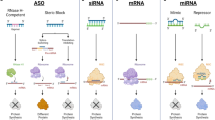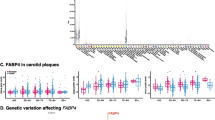Abstract
Insulin-like growth factor-1 (IGF-1) plays an important role in arterial homeostasis. Its properties seem to depend on circulating IGF-1 level changes. The various IGF-1 levels are caused by varied expression of IGF-1 gene, due to the polymorphic structure of IGF-1 gene or its regulatory sequences. We examined the P1 promoter, being responsible for most IGF-1 transcripts, in patients with stable angina, to evaluate its sequence changes and to assess its influence on protein synthesis as well as on the degree of arteriosclerosis. For that purpose we evaluated the DNA isolated from blood cells. The DNA was amplified by using polymerase chain reaction (PCR), then analyzed using the SSCP (single-strand conformation polymorphism) technique. Products of every stage were verified by electrophoresis on agarose gel. In addition, every patient had coronary angiography performed and IGF-1, IGFBP3, and lipid levels measured. The SSCP in the region between −1115 and −784 nt was less commonly observed among subjects with positive MI (myocardial infarction) familial history (P = 0.0008) and with MI history (P = 0.012) than in patients without these conditions. Subjects with this irregularity tended towards higher circulating IGF-1 levels. In addition high Gensini scores — over 95th percentile, 105 points in our study — were more frequent in SSCP patients (P = 0.03). We presume that presence of SSCP in the P1 region between −1115 and −784 nt may positively affect coronary arteries by increasing circulating IGF-1 levels, but its clinical importance requires molecular verification and further studies.
Similar content being viewed by others
References
Delafontaine P, Song Y-H, Li Y (2004) Expression, regulation, and function of IGF-1, IGF-1R, and IGF-1 binding proteins in blood vessels. Arterioscler Thromb Vasc Biol 24:435–444
Burchardt P, Gozdzicka-Jozefiak A, Siminiak T (2006) IGF-1 — a new risk factor for coronary atherosclerosis. Kardiol Pol 64:1297–1302
Van der Wal AJ, Becker AE (1999) Atherosclerotic plaque rupture-pathologic basis of plaque stability and instability. Cardiovasc Res 41:334–344
Bolster D, Kim S, Jefferson L (2004) Regulation of protein synthesis associated with skeletal muscle hypertrophy by insulin-, amino acid- and exercise-induced signaling ball. Proc Nutr Soc 63:351–356
Bienertova-Vasku JA, Vasku OHA (2007) Are common leptin promoter polymorphisms associated with restenosis after coronary stenting? Heart Vessels 22:310–315
Mizia-Stec K, Gasior Z, Zahorska-Markiewiez B, Holecki M, Kumor P (2006) Inflammatory markers in a 2-year follow-up of coronary artery disease. Heart Vessels 21:302–308
Yazdanpanah M, Rietveld I, Janssen J, Njajou O, Hofman A, Stijnen T, Pols H, Lamberts S, Witteman J, van Duijn C (2006) An insulin-like growth factor-1 promoter polymorphism is associated with increased mortality in subjects with myocardial infarction in an elderly caucasian population. Am J Cardiol 97:1274–1276
Vaessen N, Heutink P, Janssen JA, Witteman J, Testers L, Hofman A, Lamberts S, Oostra B, Pols H, Duijn C (2001) A polymorphism in the gene for IGF-1 functional properties and risk for type 2 diabetes and myocardial infarction. Diabetes 50:697–704
Withers DJ, Burks DJ, Towery HH, Altamuro SL, Flint CL, White MF (1999) IRS-2 coordinates IGF-1 receptor-mediated-cell development and peripheral insulin signaling. Nat Genet 23:32–40
Tsuruzoe K, Emkey R, Kriauciunas KM, Ueki K, Kahn C (2001) Insulin receptor substrate 3 (IRS-3) and IRS-4 impair IRS-1- and IRS-2-mediated signaling. Mol Cell Biol 21:26–38
Isenovic ER, Meng Y, Divald A, Milivojevic N, Sowers JR (2002) Role of phosphatidylinositol 3-kinase/Akt pathway in angiotensin and insulin-like growth factor-1 modulation of nitric oxide synthesis in vascular smooth muscle cells. Endocrine 19:287–292
Castrillo A, Bodelon OG, Bosca L (2000) Inhibitory effect of IGF-1 on type 2 nitric oxide synthase expression in Ins-1 cells and protection against activation dependent apoptosis: involvement of phosphatidylinositol 3-kinase. Diabetes 49:209–217
LeRoith D, Werner H, Beitner-Johnson, Roberts CT Jr (1995) Molecular and cellular aspects of the insulin-like growth factor I receptor. Endocr Rev 16:143–163
Saltiel AR, Kahn CR (2001) Insulin signaling and the regulation of glucose and lipid metabolism. Nature 414:799–806
Schini-Kerth VB (1999) Dual effects of insulin-like growth factor-1 on the constitutive and inducible nitric oxide (NO) synthase-dependent formation of NO in vascular cells. J Endocrinol Invest 22:82–88
Michell BJ, Griffiths JE, Mitchelhill KI, Rodriguez-Crespo I, Tiganis T, Bozinovski S, de Montellano PR, Kemp BE, Pearson RB (1999) The Akt kinase signals directly to endothelial nitric oxide synthase. Curr Biol 9:845–848
Renier G, Clement I, Desfaits AC, Lambert A (1996) Direct stimulatory effect of insulin-like growth factor I on monocyte and macrophage tumor necrosis-a production. Endocrinology 137: 4611–4618
Hochberg Z, Hertz P, Maor G, Oiknine J, Aviram M (1992) Growth hormone and insulin-like growth factor I increase macrophage uptake and degradation of low-density lipoprotein. Endocrinology 131:430–435
Juul A, Scheike T, Davidsen M, Gyllenborg J, Jørgensen T (2002) Low serum insulin-like growth factor I is associated with increased risk of ischemic heart disease: a population-based case-control study. Circulation 106:939–944
Janssen JA, Stolk RP, Pols HA, Grobbee DE, Lamberts SW (1998) Serum total IGF-I, free IGF-I, and IGFB-1 levels in an elderly population: relation to cardiovascular risk factors and disease. Arterioscler Thromb Vasc Biol 18:277–282
Grant MB, Wargovich TJ, Ellis EA, Caballero S, Mansour M, Pepine CJ (1996) Expression of IGF-I, IGF-I receptor and IGF binding proteins-1, -2, -3, -4 and -5 in human atherectomy specimens. Regul Pept 67:137–144
Okura Y, Brink M, Zhadi AA, Anwar A, Delafontaine P (2001) Decreased expression of insulin-like growth factor-1 and apoptosis of vascular smooth muscle cells in human atherosclerotic plaque. J Mol Cell Cardiol 33:1777–1789
Author information
Authors and Affiliations
Corresponding author
Rights and permissions
About this article
Cite this article
Burchardt, P., Nowak, W., Gozdzicka-Jozefiak, A. et al. Presence of irregularity in region between −1115 and −784 nt in P1 promoter of Insulin-Like Growth Factor-1 gene may indicate beneficial effect on coronary arteries in a group of patients with stable angina: preliminary data. Heart Vessels 24, 254–259 (2009). https://doi.org/10.1007/s00380-008-1116-z
Received:
Accepted:
Published:
Issue Date:
DOI: https://doi.org/10.1007/s00380-008-1116-z




